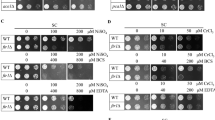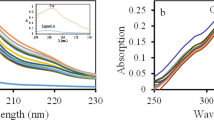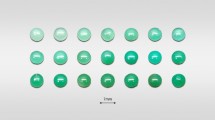Abstract
THE most sensitive chemical method of detection of iodine-containing substances on paper chromatograms is the application of the ceric sulphate–arsenious acid reaction1. By the use of this method the iodine-containing substances are indicated by white spots on a yellow background. Fletcher and Stanley2 obtained white spots on a brown background by spraying such chromatograms with 1 per cent o-phenylenediamine in acetone.
This is a preview of subscription content, access via your institution
Access options
Subscribe to this journal
Receive 51 print issues and online access
$199.00 per year
only $3.90 per issue
Buy this article
- Purchase on Springer Link
- Instant access to full article PDF
Prices may be subject to local taxes which are calculated during checkout
Similar content being viewed by others
References
Bowden, C. H., Maclagan, N. F., and Wilkinson, J. H., Biochem. J., 59, 93 (1955).
Fletcher, K., and Stanley, P. G., Nature, 175, 730 (1955).
Author information
Authors and Affiliations
Rights and permissions
About this article
Cite this article
DRAGÚNOVÁ, I., LANGER, P. Detection of Iodine-containing Substances on Paper Chromatograms. Nature 178, 537–538 (1956). https://doi.org/10.1038/178537a0
Issue Date:
DOI: https://doi.org/10.1038/178537a0
This article is cited by
-
Dünnschicht-Chromatographie
Fresenius' Zeitschrift für analytische Chemie (1964)
-
Diglycols�ure-di-(3-carboxy-2,4,6-trijodanilid) (Ioglycamid), ein Kontrastmittel f�r intraven�se Cholangiographie
Naunyn-Schmiedebergs Archiv f�r Experimentelle Pathologie und Pharmakologie (1964)
-
Chromatographic Detection of Minute Quantities of Thyroxine in Serum
Nature (1958)
Comments
By submitting a comment you agree to abide by our Terms and Community Guidelines. If you find something abusive or that does not comply with our terms or guidelines please flag it as inappropriate.



